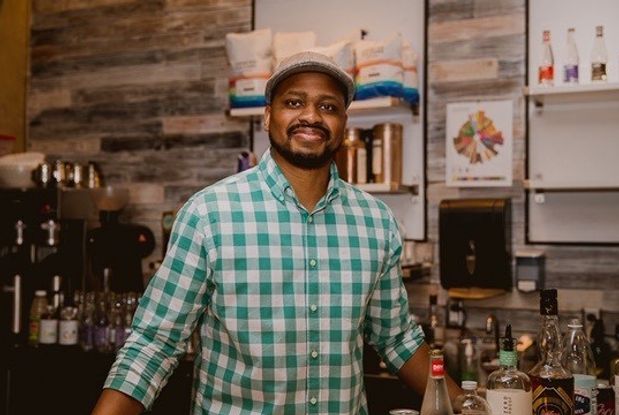Sans Bar, an alcohol-free bar in Austin, Texas, that prizes the “zero-proof cocktail,” started hosting virtual events last year as the pandemic drove life online. Its early events saw high attendance, says founder Chris Marshall, with as many as 300 people logging on to make a drink and connect with others.
The virtual events “were a lifesaver for a lot of people” who felt disconnected from their support communities during COVID-19, said Marshall, a former substance-abuse counselor who is 14 years sober. Many have gravitated to the bar in search of ways to reshape their relationship with alcohol.
“ ‘We’re going to see people looking for ways to stop or slow their pandemic-level alcohol consumption.’ ”
“Everyone’s feeling this stress, everyone’s looking for that tool to help them navigate that stress, and a lot of people are using alcohol. But they’re also finding — on the other end of things — that that tool can really become a vice, and something that hinders them from achieving the things that they want,” Marshall, 38, told MarketWatch.
As the bar opens back up on a limited basis, it’s seeing many new faces, he added. But the pandemic has left a lasting effect, Marshall said. A handful of patrons have told staff that they’re seeking community support because they’re struggling to abstain from drinking at home.
Sans Bar is also working with people in nine U.S. states and three Canadian provinces who have enrolled in Sans Bar Academy, a 10-week course to help them open their own alcohol-free establishments within the next year. This, Marshall said, “is a sign that there’s a genuine demand as we enter the new normal.”
“We’re going to see people looking for ways to stop or slow their pandemic-level alcohol consumption,” he said.
Increased drinking during the pandemic
Alcohol sales surged in the pandemic’s early months, and a number of small studies now show that some people are drinking more to cope with pandemic-related stress, George Koob, the director of the National Institute on Alcohol Abuse and Alcoholism (NIAAA), told MarketWatch.
One study published as a research letter in JAMA Network Open found that U.S. adults’ frequency of alcohol consumption in 2020 increased 14% over 2019, and heavy drinking among women (four or more drinks within a couple of hours) rose 41%. Women also had a 39% increase in negative consequences of drinking, the study showed.
Another survey, conducted in the pandemic’s early months and published this year in the journal Preventive Medicine, found that 29% of respondents who drank reported increasing their drinking since COVID-19, with people who have anxiety or depression symptoms even more likely to have increased their use. About 20% reported drinking less and half reported no change in their drinking.
“ ‘Alcohol use is one of the most common coping strategies for dealing with distress, and things like mental distress and financial distress all went up during the pandemic.’ ”
“The research shows pretty clearly that early on, there were increases in the amounts people drank, how frequently they drank, and the consequences of drinking,” Michael Pollard, a co-author of the JAMA Network Open study and a senior sociologist at the RAND Corporation, told MarketWatch.
“There’s been less data out there on whether or not this has continued — but studies that have come out suggest that yes, the alcohol consumption has continued to be elevated compared to pre-pandemic [times],” he added.
More recently, an American Psychological Association survey conducted in late February found that nearly 1 in 4 adults reported increased drinking to cope with stress, including 52% of parents with kids ages 5 to 7.
“Alcohol use is one of the most common coping strategies for dealing with distress, and things like mental distress and financial distress all went up during the pandemic,” Pollard said, ticking off contributing factors such as widespread job loss, isolation and loneliness, and health concerns.
Previous social traumas, such as the 9/11 terror attacks and Hurricane Katrina, have also been associated with increased alcohol use.
The amount of alcohol consumption per person was already rising among adults pre-pandemic, particularly among women, Koob said. Alcohol-related deaths doubled between 1999 and 2017, NIAAA research has found, with bigger increases for women than for men. And alcohol-related liver-disease deaths were increasing prior to COVID-19, particularly among young drinkers in their 20s and 30s.
What’s more, alcohol contributes to three factors that loom in so-called deaths of despair, namely suicides, overdoses and liver disease, Koob said.
“A lot of these were occurring before the pandemic — our fear is they’re going to be exacerbated by the pandemic,” Koob said. “The data seem to indicate that so far.”
‘Women are under an incredible amount of stress’
The pandemic’s impact on women’s alcohol consumption is particularly concerning, Pollard said: While men already drank more and had higher rates of alcohol-use disorder than women, there has been a long-term increase in women’s alcohol use “that the pandemic really seems to have revved up.”
A recently published study by Susan Stewart, an Iowa State University sociology professor, showed that pandemic-related anxiety was associated with women’s increased drinking, with almost 2 in 3 women surveyed last June reporting drinking more since the pandemic’s start, including binge drinking, daily drinking and drinking earlier in the day.
“ Almost 2 in 3 women surveyed last June reporting drinking more since the start of the coronavirus pandemic. ”
“Women are under an incredible amount of stress since COVID,” Stewart said. “They’re more likely to be essential workers, yet they’re more likely to have been laid off. They’re primarily responsible for [children’s] remote learning, yet they’re still working part-time or full-time. They’re doing housework; they’re taking care of relatives.” Husbands and male partners, she added, “just aren’t doing their share, even if they’re home.”
Factors like shame, guilt, fear of being seen as a “bad mom,” potential loss of child custody, and lack of gender-specific treatment stand in the way of women getting treatment for alcohol overuse, Stewart wrote in her study, which included a mostly white, college-educated sample of 546 women that wasn’t generalizable to the national population.
She believes that the much-analyzed “wine mom” culture, some of which manifests as women sharing blithe memes about drinking to get through the day, is on the rise during COVID-19.
“My feeling is this seeps out in codes,” Stewart said. “This is the language they use to communicate and to reach out to others who may be having the same struggles.”
The science on understanding women’s alcohol use and treating alcohol-use disorder in women is lacking, Pollard added, as is the body of research assessing the efficacy of standard alcohol-use disorder treatments in women.
“It’s clearly a problem, and we’re sort of lagging behind in trying to understand how to cope with it and treat it,” he said. “The pandemic has accelerated the need and demonstrated the need to really look at this.”

Chris Marshall, the founder of alcohol-free Sans Bar in Austin, strives to elevate the ‘zero-proof cocktail.’
Courtesy of Chris Marshall
‘The pandemic made me go into a sort of a shell’
Close to 15 million people in the U.S. have an alcohol-use disorder, which can be mild, moderate or severe. Though “it’s largely supposition at this point,” the pandemic has posed obstacles for people with an alcohol-use disorder to get the same support, whether that’s group therapy, individual psychotherapy, Alcoholics Anonymous meetings or treatment centers, Koob said.
“All these things have been compromised,” he said. “The good news is that telehealth has stepped in to a large extent, and people are utilizing it.”
“ New Method Wellness, a treatment center in San Juan Capistrano, Calif., has seen alcohol-related treatment requests increase more than 30% since before the pandemic. ”
Reports from across the country do suggest that amid the uptick in alcohol use, many people have sought help.
For example, New Method Wellness, a treatment center in San Juan Capistrano, Calif., has seen alcohol-related treatment requests increase more than 30% since before the pandemic, a trend that picked up in November and December and continues today, according to a spokesperson. (The treatment center offers several different programs, accepts all major insurance and “in most instances, up to 100% of our services are covered,” according to its website.)
One of its clients was Jeffrey F., a 34-year-old Orange County, Calif., resident who has sought treatment for drug and alcohol abuse several times since he was a teenager, and whose full name MarketWatch is not publishing at his request.
“ ‘It didn’t take long for my mind to sort of tell me, well, we know the best way to fix this feeling of anxiety or discomfort, and that’s to reach for a drink.’ ”
In the period leading up to the pandemic, Jeffrey’s life was looking up: He was two and a half years sober, had a good job, had restored relationships with family and friends, and was participating in support-group meetings. Things were going so well, he eased up on attending meetings — meaning that when COVID-19 hit, he already felt disinclined to participate in meetings that had gone virtual.
“The pandemic made me go into a sort of a shell: I became isolated and apart from other people and less connected,” Jeffrey said — “extremely dangerous territory” for him. “It didn’t take long for my mind to sort of tell me, well, we know the best way to fix this feeling of anxiety or discomfort, and that’s to reach for a drink.”
Jeffrey went to a detox facility and began a 30-day residential treatment in September at New Method Wellness, where he had previously had success. The center helped Jeffrey reestablish healthy habits, gain insights into his relapse, and find purpose by helping some younger clients in his treatment program, he said.
In an early-May interview, he said he was doing well with a little over eight months sober. “It’s amazing how quickly things can go bad, but it’s amazing how quickly things can be repaired and restored, in my experience, as well,” Jeffrey said.
Tempest, a digital alcohol-use disorder recovery program, has tripled its paid membership year over year, according to its CEO, Ruth Sun. (Tempest offers a “core” one-year membership for $59 a month, and an “intensive” four-week program for a one-time payment of $399.)
It has also seen more than 50,000 new members since the start of 2020 join its free community, which includes an email newsletter and offerings like 10 free meetings for May’s Mental Health Awareness Month.
Common themes the organization is hearing from new members include pressure to balance work with life and caregiving responsibilities during the pandemic, as well as social isolation. The organization has also received interest from employers looking to support employees in reducing their alcohol consumption, Sun said.
Meanwhile, Anna Lembke, a psychiatrist and chief of the Stanford Addiction Medicine Dual Diagnosis Clinic, said in a Stanford Medicine Q&A last year that her clinic had seen a slight uptick in people seeking treatment for addiction, “but not necessarily because their problems have gotten worse since the pandemic.”
“Most of our new patient visits are people who have been struggling on and off for a long time, and sheltering in place has given them the time and motivation to seek help,” she said. Zoom ZM, -2.56% visits also eliminated geographic barriers to treatment, she added, decreasing the no-show rate and drawing queries from prospective out-of-state patients.
How to stop drinking (or drink less)
Some people can drink in moderation, while others choose to abstain entirely. Whether you’re looking for resources to address alcohol-use disorder or are simply drinking more than you’d like to, here are some strategies and resources that may help.
Track your drinking and try an ‘intentional pause’
You can start by assessing how much you’re drinking and how much help you need cutting back, Pollard said. One tool for doing so is Cutback Coach, a moderation-focused platform that helps users track their drinking and build healthier habits.
Marshall suggests taking an “intentional pause” from drinking for a set amount of time — say, two weeks or a month — to reassess your relationship with alcohol, see how you’re doing and identify whether you’re leaning on alcohol to manage stress or anxiety.
The NIAAA website Rethinking Drinking has information on what counts as a “standard” drink and the U.S. dietary guidelines for alcohol, as well as calculators for mixed-drink content, drink size, alcohol calories and alcohol spending, Koob added.
Keep the ritual, but replace the alcohol
It’s now entirely possible to find a great nonalcoholic wine, beer or spirit for the times when you would normally consume alcohol, Marshall said, whether it’s part of your ritual or to mark the passage of time.
“If you’re used to making an old-fashioned after work, you can make that without alcohol now,” Marshall said. “Finding a replacement is the most accessible way to change your relationship with alcohol.”
Seek support and/or treatment that suits your needs
Find at least one person with whom you can be completely honest and who will listen without judgment, whether that’s a significant other, family member, friend, religious leader, doctor or therapist, Jeffrey said.
Having an accountability buddy can be helpful, added Ruby Mehta, Tempest’s director of clinical operations. You can also seek therapy, find a recovery coach or see if you have a program covered through your employer that focuses on behavioral changes and creating new habits, she said.
As for support groups and communities, A.A. may be a good option for you; there are also many alternatives, including SMART Recovery, the Reddit community r/StopDrinking, Tempest and The Luckiest Club. Moderation Management provides support to both people who want to moderate their alcohol consumption and those who choose to abstain altogether.
“ ‘One of the most important things to me is to be connected to a community.’ ”
“One of the most important things to me is to be connected to a community — to be connected to other people that are struggling with the same or similar issues, and to try to be useful and helpful to those people,” Jeffrey said.
Looking for treatment? NIAAA’s Alcohol Treatment Navigator provides information on alcohol-use disorder, the kinds of treatments available, and how to find science-backed care from alcohol-treatment programs, therapists and addiction doctors in your area.
You can also call the Substance Abuse and Mental Health Services Administration’s (SAMHSA) free, confidential National Helpline at 1-800-662-HELP (4357) for treatment referral and information.
Take care of yourself
Common-sense ways to relieve stress and help you cope include getting enough sleep, eating well and engaging in social interaction, Koob said. Tend to your own needs, build in moments of exercise and movement throughout the day, and carve out time for meditation or hobbies like cooking or writing, Mehta said.
Celebrate your wins
However long you’ve made it without a drink — three days, two weeks or a month — “celebrate that,” Marshall said. Acknowledge the fact that you’ve swapped in nonalcoholic drinks for half your usual number of beers. This recognition “helps to make you feel like you’re accomplishing something,” he said.
And if you’re feeling alone, afraid or ashamed, reach out to someone and seek help, Jeffrey said. “It may feel like you’re alone, but you’re absolutely not alone.”








